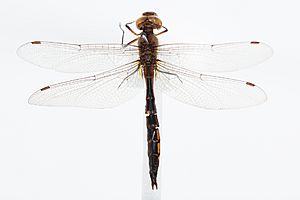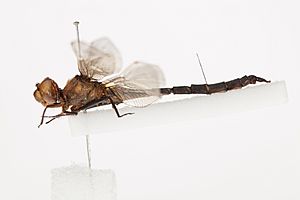Smith's dragonfly facts for kids
Quick facts for kids Smith's dragonfly |
|
|---|---|
 |
|
| A preserved specimen from the Auckland Museum | |
| Conservation status | |
| Scientific classification |
Procordulia smithii, also called Smith's dragonfly or the ranger dragonfly, is a type of dragonfly. It is found only in New Zealand, just like its close relative, Procordulia grayi.
People started to get interested in New Zealand dragonflies during Captain Cook's trips. The first collection of these insects was made in 1842. A scientist named George Hudson studied dragonflies in New Zealand a lot. He sometimes found it hard to tell P. smithii and P. grayi apart because they look very similar.
Dragonflies belong to an insect group called Odonata. We have many fossils of Odonata, which helps us learn about their past. Scientists have found that where dragonflies live often depends on the climate. Many different types of dragonflies live in tropical forests. This suggests that warm places have the most dragonfly species. However, P. smithii is very common in the South Island and the lower North Island. This shows that this species likes cooler places. Its eggs can even survive freezing temperatures!
Contents
What Does Smith's Dragonfly Look Like?
Procordulia smithii has large, round eyes that touch each other and cover most of its head. Male dragonflies have green eyes that shine a little. Females have brown eyes that do not shine. These eyes are great at spotting movement and changes around them. They help the dragonfly see like a radar.
The body of Procordulia smithii is long and tube-shaped. It is a bit flat and is black or dark brown. When this dragonfly flies, you might see bright pale-yellow stripes on its body. These are the parts between its body segments.
P. smithii has thin, spiny legs. These legs are perfect for catching prey and carrying it while flying. Its wings are very flexible. They have a small bend called a nodus in the middle. This bend allows the wing to flex and bend during flight. A small, dark spot on the wing, called a pterostigma, helps keep the wing stable. P. smithii is usually about 46 to 50 millimeters long. The legs closest to its body are brown, while the ones further away are black. Dragonflies of this species found in the Chatham Islands can have different colors than those on the main islands.
Where Do Smith's Dragonflies Live?
Procordulia smithii is only found in New Zealand. However, it is closely related to dragonfly species found in Australia and the Pacific. Scientists believe P. smithii came to New Zealand a long time ago, during a warm period between ice ages.
You can find Procordulia smithii on New Zealand's main islands and some coastal islands. This includes Little Barrier Island and the Chatham Islands. It is especially common in the Canterbury area of the South Island.
P. smithii lives all over New Zealand. It is very common in the South Island and the southern parts of the North Island. However, it is not often seen in the northern parts of the North Island. Scientists think more study is needed to understand why. The number of P. smithii dragonflies has also changed since the 1950s.
You can find P. smithii near many types of water. These include wetlands, streams, creeks, swamps, marshes, and even waterfalls. Young dragonflies (larvae) are often found in beds of plants like bulrushes. They also live in small bog ponds near streams and pools. Adult dragonflies are usually found near streams. Sometimes, P. smithii can even be found in grasslands up to five kilometers away from water.
Life Cycle of the Dragonfly
Procordulia smithii does not have a pupa stage, which is a resting stage between the young (larva) and adult forms. It takes about four years for Procordulia smithii to complete its entire life cycle. These dragonflies lay their eggs in shallow, still water. Scientists still need to learn more about how long it takes for all dragonfly species to grow up. They suggest marking dragonflies and then finding them again later to study this.
Young P. smithii larvae live only in fresh or slightly salty water. They do not leave the water until their wing covers have grown halfway through their development. Their mating behaviors are quite interesting and unique.
What Do They Eat?
Male Procordulia smithii dragonflies in Cass, Canterbury, fly about 0.7 kilometers each day to find food. They go to nearby river flats and then return to their home area the next morning. Dragonflies, both young and adult, are very good hunters. They usually eat small flying insects. Dragonflies are considered top predators in freshwater places. A lion might catch its prey only 25% of the time. But dragonflies are much better, catching their prey about 95% of the time!
Threats to Smith's Dragonfly
Procordulia smithii is not currently in danger. It is listed as a species of 'Least Concern'. However, like many other animals, P. smithii can be affected by climate change. Dragonflies living in high places might struggle if their habitat changes too much. Also, species in warmer, tropical areas face problems like trees being cut down and rising temperatures. These changes can lead to species loss.
Adult dragonflies are often eaten by different types of trout and spiders. Small creatures called mites can also affect dragonflies. There is not much information about other parasites or diseases that affect P. smithii. More study is needed to understand this species better, especially how climate change might impact it.
Images for kids




